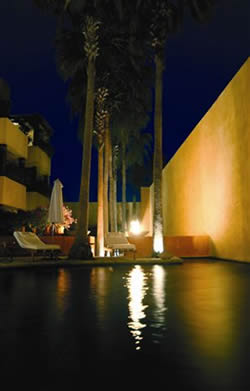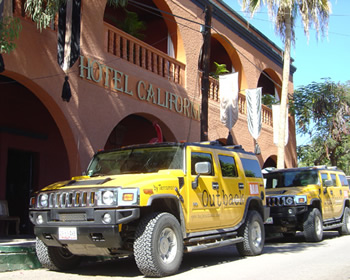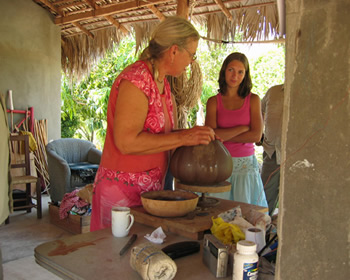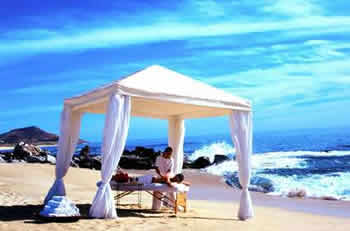 |
|
|
|
|
|
|
|
|
|
|
|
|
|
|
|
|
|
|
|
|
|
|
|
|
|
|
 |
 |
|
|
|
|
|
|
|
|
|
|
|
|

|
Los Cabos, Mexico Where the desert meets the sea Perhaps the local wag exaggerates when he proclaims that Los Cabos gets three days of rain a year, whether it needs it or not. Three days, around about the 19th of September--and yes, hurricanes may be involved, but isn’t that a small price to pay for 362 days of perfect weather? This New Yorker, who left an unseasonably cold May back home to venture to the southernmost tip of the Baja Peninsula, agrees. The air here tastes sweet and clean, delicious enough so merely breathing might be listed as an official indulgence. Seven hours of air travel quickly recede into dim memory upon arrival in this idiosyncratic Mexican paradise.
We’ve come at the end of the seven-month high season, and desert dryness still tempers the nonstop sunshine. Days in the mid-70s dip into the sort of evening coolness that invites a shawl or jacket. Given the dryness, how can it be that certain aspects of the environment are a lush and variegated green? It’s all about the proximity of the ocean and labyrinthine subterranean roots designed to capture and store such moisture as there is. Summer is reputedly sticky, but we’re not in it yet. One of our party plays 18 serious holes of golf everyday--Jack Nicklaus has proclaimed this the most beautiful place on earth to play golf--and rejoins us for cocktails looking unfazed. The brightness is nontrivial, however, and early tee times are the most desirable. Los Cabos--The Capes, sometimes called simply Cabo--comprises the area from San Jose del Cabo to southernmost Cabo San Lucas, where the Pacific meets the Sea of Cortez. Between these two distinctly different communities stretches Los Cabos Corridor, 18 beach-front miles thick with pastel-hued resorts. In common with other land’s end resort areas, Los Cabos offers dramatic nature, honky-tonk revelry, history both tastefully preserved and well packaged for tourism, delicious seafood, and an ineffable something that draws artists, writers, and those who seek a touch of rough magic along with flagrant luxury. A brief trip there may leave one hungering to devote weeks or months to explore the whole of Baja, the world’s third-longest peninsula; but the turn-around traveler will be requited by the range of contrasting pleasures within easy reach. Europeans started arriving here without invitation in the 16th century. It was only in the mid-1950s, though, when the son of a former Mexican president built a hotel on the Corridor, that Los Cabos began to have cachet as a vacation spot. A highway the length of the peninsula opened it up further in the mid-1970s, and then in 1986 came an international airport near San Jose del Cabo. To judge from the amount of building visible at nearly every turn, the boom is anything but over. While some people may find construction sites unaesthetic, others are energized by a hopeful feeling in the area. Debates rage over whether it’s a good or bad thing that zoning is laissez-faire; Office Depot and other familiar American brands dot the landscape, and the occasional high-rise obscures the ocean view. A local defending the aesthetic compromises pointed out a development of one-family homes for workers. "No one could afford these if we had no place to work except authentic little tumble-down shops." The tourist benefits: the traveler feels welcomed, not resented. English is often spoken, dollars are accepted as currency, and the service industry appears to be a cadre of proud professionals, gracious and energetic. What to do
Eco-tour. Take the wheel of a bright yellow Hummer, or opt to be a passenger and know the thrill of driving off-road without needing to call AAA. The knowledgeable, passionate guides at Baja Outback offer a variety of itineraries, from one-day explorations to more rugged and comprehensive eco-tourist packages including lodging. Our mini-meander took us into a dusty valley where the temperature suddenly dropped, emaciated cattle struggled from oasis to oasis, and we felt like time travelers or perhaps visitors to a parallel universe with a whole new set of givens. We visited the enclave called Candeleria, where Lorna Hankins, an American émigré who has become a local legend, teaches local woman not just to make pots but to sign and sell them. No electricity, no indoor plumbing; and Lorna seemed to make a point of stoking her wood-fired stove, where an iron pot brought drinking water to a boil. As she offered fruit from her heavy-laden mango tree, a sigh of contentment ran through our little group. Then we were happy to get back into the Hummers and head for a restaurant with iced drinks and flush toilets. Perhaps a point of eco-tourism is to make us secretly grateful for civilization and its discontents? http://www.bajaoutback.com Go not-so-eco tourist. Swim with dolphins, who were rescued from a dicey situation in Japan, but don’t always look grateful for a life of "interacting" with human beings. At Cabo Dolphins, $165 buys a half hour with one of seven Blue-Nose dolphins, all named for painters. The facility was brand new when we visited; the palm trees hadn’t yet filled out, so shade was skimpy (and sunscreen isn’t allowed). Other grumbles: You have to wear a flotation device, wait your turn, hear a lot of whistle-blowing, follow the trainers’ directions, and deal with awkward software if you want to buy a photo of yourself with your dolphin. And you might get unlucky like the fellow, in another group, whose dolphin had an extreme digestive moment during their romp. For all of that, it’s an experience as sublime as it is silly. Urban you hurtling bareback on a cool, silky massive yet tender being that smells agreeably like a sushi bar. I have framed and hung the photo of Frida kissing my cheek: The camera has never caught me with a wider smile. The moral may be that the less you want to swim with dolphins, the more you need to. http://www.cabodolphins.com
Have lunch in Todos Santos, a small town that pulls you back into history, yet doesn’t proffer an intimidating must-see checklist. Here are galleries featuring local artists; a bookshop that also sells organic jams; low-key clothing and jewelry shops; and streets for simply wandering and admiring the pastel colors, tile-work, and appealingly odd angles of the low-slung buildings. Former rock fans, now completely grown-up and part of the Establishment, seem irresistibly drawn to the funky ritzy Hotel California, where the iconic Eagles song of the same name plays in the gift shop. Tourism promoters make much of the connection, which single-handedly made this a destination, although many newspaper articles and websites quote song-writer Don Henley as saying no member of the band ever stayed there or meant the song to reflect an actual inn. Cruise around Los Arcos, the soaring arches of pale, craggy rock where the Sea of Cortes meets the Pacific. The explorer Cortes is also a subject of debate and revisionism, but that doesn’t dim the beauty of the blue-green water rising and falling between Baja and the Mexican mainland. The cruise ships of the Caborey line ply a route heading south from Cabo San Lucas and circling the arch before returning. In season there are whale-watching and snorkeling trips; those who want to stay dry--on the outside, anyway--may opt, as we did, for a sunset dinner cruise with floor show or a margarita cruise. We were warned that seas are occasionally rough but none of our group experienced discomfort. We especially enjoyed the young tango dancers on stage and rated the food (except for dessert) above average. Email: caborey@prodigy.net.mex or tel. 011-52-624-143-8260 And: Spend an hour in Cabo San Lucas, if you want to feel as though you’re on the inside of a pinball machine. Between the surfer bars and sunglass emporia, you will also find places to spend serious money on worldly goods, notably silver jewelry and Cuban cigars. Experiences not personally sampled but a big draw for visitors includes golf on one of many highly ranked courses; sport fishing; and getting married. Cabo welcomes couples who want the opposite of City Hall, with some parties taking over boutique hotels such as the coolly mysterious 16-room Casa Natalia in San Jose del Cabo and others thinking big at the likes of the Hilton’s surfside beach pavilion, where 1,100 guests can enjoy a plated dinner. (See more about Casa Natalia and the Hilton below.) Where to stay
Hilton Los Cabos Beach & Golf Resort, on the Corridor, has a sense of place and a singular style that should belay any apprehension about staying in a chain hotel. You need not read the plaques commemorating its awards within the Hilton family to sense that service here is a standout--the elusive perfect blend of warmth and formal courtesy. As it is, the rooms are well-appointed, with the exemplary staff making the most of what’s there. We were greeted by personal welcome messages in tiny seashells spelled out across the sand tones of the bedspread. Some evening, you, too, may come from dinner to find the big round tub filled with steaming water afloat with flower petals. If you prefer a savory goodnight bite instead of the usual chocolate to dream upon, that’s what will be left for you. Private balconies off each room afford various views of the hotel property and the sea but aren’t the main draw; you may use yours for quick-drying swim togs rather than hanging out. But sleep with the drapery pulled back and you will awaken to sweet bird calls and a sunrise of sorbet-color streaks. Sleep: I defy anyone to stay conscious more than five minutes into the Swedish massage, a proper blend of serious muscle work and soothing strokes, offered at the Ixchel Spa. A gracious lounge area lets you hang on to the good feeling until you’re ready to face the real world. I appreciated a minimum of incense, twinkle ding dong music, and other New Age frills (or distractions, depending on your orientation). A pedicure felt thorough without occupying too much of a precious day. I found the air over-chilled on both my visits. The hotel literature boasts that it offers fine ocean swimming, the only such private beach on the Corridor. The red flag was flying throughout my whole visit, however, and I was told that ocean swimming is in fact always discouraged because of tricky tides. The huge infinity pool is tremendous consolation. Approach it from the right angle, and you see only horizon; the sensation is that you could keep going forever. A swim-up bar, one of the great sybaritic pleasures, dispenses drinks from mid-day on. Perhaps the biggest surprise of my stay at the Hilton was the very high quality of the food. Hotel buffet breakfasts are often a debased experience, but not when you begin with a choice of maybe a dozen exotic fresh juices, including starfruit, cactus, and various melons as well as the standby citrus. Ordering from the a la carte menu brought me one of the ten best egg dishes I have met: poached eggs over spinach atop a sope, a corn tortilla so thick and dense it almost qualified as a pudding, with a chipotle hollandaise gilding the lily yet perfectly necessary.
Although I wasn’t in Cabo long enough to tire of regional food, I appreciated a grand dinner at Fenicia, which offers a long menu of contemporary dishes emphasizing the northern Italian, with flavors of Morocco and many New American touches. Typical: a succulent veal chop successfully paired with cassis-spiked stewed strawberries. Executive Chef Gerald Blay features the best of local ingredients in all the hotel restaurants, so there’s fish from the Cortez, a range of Mexican wines, and exemplary produce from organic farmers just up north. (Cabo is a major source for Mexican-grown organic tomatoes exported to the U.S.) Unfair to promise you the moon, but unthinkable to omit mention of the one that hung before us as we dined al fresco at Fenicia. Orange as a Halloween pumpkin, oblate as a blimp, it stopped conversation as it rose in the cloudless black sky. A tour of the kitchen with affable, gregarious Canadian-born Chef Blay was a highlight of our trip. It’s possible to dine in the kitchen (the chef’s table looked to seat eight or ten) or have a walk-through or private demo-lesson: recommended. For North Americans chary of eating fruits and vegetables once they cross the Mexican border, Chef Blay’s kitchen is more reassuring than the FDA commissary. "Vegetables go in there for an iodine wash," he said, pointing to a three-bay sink, "then they get a soap and water wash, and then they’re rinsed. And then," pointing theatrically, "they go in that refrigerator. Marked ‘dirty.’ And we begin." http://www.hiltonloscabos.com. Where to eat ex-resort A visit to Cabo isn’t complete without an early evening in San Jose del Cabo, the geographical and stylistic opposite of Cabo San Lucas. Here is the paradigmatic shady town square flanked by Spanish Colonial buildings, under the beneficent gaze of a hushed and serene church. Mi Cocina at Casa Natalia offers sophisticated dining under the whisk of Chef Loic Tenoux, who owns the property with his wife, Nathalie. European-born, Mexican residents for a decade, the couple have created a polished, modern establishment that has melded with the surroundings. The dark wood, palm-filled courtyard, and flaming braziers blur the line between nature and shelter. This is a good place to order flights of small dishes, such as steamed clams and scallops with cilantro-flecked cream, and a sliced duck salad with jicama marinated in lime and honey. http://www.casanatalia.com Last word Don’t count on the San Jose airport to provide an amazing range of tequilas. The selection is middling and the tax-exempt factor is hardly life-changing. More disappointing yet, when you get back home you’ll find you’ve lost the ability to sip margaritas all day long and not get a headache. For that, you have to go back to Cabo. --Nancy Weber Summer, 2006 |
||||||||||||




